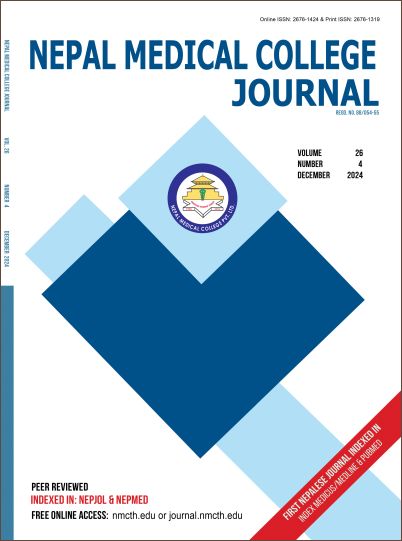Evaluation of Postoperative Analgesic Efficacy of Intraperitoneal Ketamine plus Bupivacaine in Laparoscopic Surgery
DOI:
https://doi.org/10.3126/nmcj.v26i4.74469Keywords:
Intraperitoneal, ketamine, bupivacaine, postoperative pain, laparoscopies surgeriesAbstract
Laparoscopic surgery is considered as the gold standard for minimally invasive procedures for abdominal and pelvic surgeries and thought to be less painful compared to open surgeries. Local anesthetic instillation alone addresses parietal pain relief; therefore, the use of adjuvants has been investigated to augment pain relief. To evaluate the change in hemodynamic parameters and analgesic effect of intraperitoneal ketamine plus bupivacaine in patients undergoing laparoscopic general and gynecological surgery, to evaluate pain by using Visual Analog Scale (VAS), time for first rescue analgesia demand, total analgesic consumption in first postoperative day and any drug-related complications during the postoperative period. Fifty seven patients scheduled for laparoscopic general or gynecological surgery were randomly assigned to receive intraperitoneal ketamine 0.5mg/kg plus bupivacaine (0.5% 15ml) diluted in 15 ml of normal saline to make 0.25% bupivacaine. This solution was installed intraperitoneal and infiltrated at incision site at the end of surgery. Then the patients were tilted according to surgeries; Trendelenburg’s position to target the hepatodiaphragmatic space in the gall bladder bed and reverse Trendelenburg’s position in gynecological surgery to target the pelvic floor. The patients received intraperitoneal ketamine plus bupivacaine reported lower pain scores throughout the postoperative period with VAS scores observed lower on arrival in the postoperative ward, with less demand of supplemental rescue analgesia. No postoperative complications were observed. Intraperitoneal instillation of ketamine plus bupivacaine at the end of laparoscopic surgery was an effective and safe method for pain relief during the postoperative period with less demand for supplemental systemic analgesia, high patient satisfaction and no complications.
Downloads
Downloads
Published
How to Cite
Issue
Section
License
Copyright (c) 2024 Nepal Medical College Journal

This work is licensed under a Creative Commons Attribution 4.0 International License.
This license enables reusers to distribute, remix, adapt, and build upon the material in any medium or format, so long as attribution is given to the creator. The license allows for commercial use.




